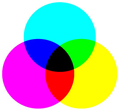Posted by Mike McDermott on
There are different color modes a graphic designer uses when preparing artwork for print (CMYK) and screen (RGB).
 If your printer is using a digital press, they will use 4-color process inks. The inks used are Cyan, Magenta, Yellow, and Black, or CMYK. These transparent inks are broken into dots that overlap in different combinations to create a wide variety of colors. Take a magazine photo and look at it through a magnifying glass. You will see the cyan, magenta, yellow and black dots that make up the printed photo.
If your printer is using a digital press, they will use 4-color process inks. The inks used are Cyan, Magenta, Yellow, and Black, or CMYK. These transparent inks are broken into dots that overlap in different combinations to create a wide variety of colors. Take a magazine photo and look at it through a magnifying glass. You will see the cyan, magenta, yellow and black dots that make up the printed photo.
CMYK is a subtractive process, which means that cyan, magenta, and yellow inks are combined to create thousands of other colors. In theory, if the first three colors are overlapped, you would get black. But in reality, the result of this combination is a muddy, dark-brown look. Therefore, black has been added to completely remove the light from the printed picture, which is how the eye perceives the color black.
 Online graphics, such as those used in a website or on television, break down light into Red, Green, and Blue (RGB). RBG is an additive color process in which red, green and blue light are overlapped in different combinations to create thousands of other colors. In theory, if these colors are overlapped, the result would be pure white.
Online graphics, such as those used in a website or on television, break down light into Red, Green, and Blue (RGB). RBG is an additive color process in which red, green and blue light are overlapped in different combinations to create thousands of other colors. In theory, if these colors are overlapped, the result would be pure white.
So, how does this all apply to your label?
If you are viewing your label’s artwork on a computer monitor in RGB mode, you will be disappointed in the color when your label is printed. RGB offers a much wider range of colors than CMYK, and RGB colors are more vivid than CMYK. Because you see color through the light of the monitor, many of the colors you see cannot be duplicated using CMYK inks. Have your designer convert the file to CMYK and print it on a color printer. This will give you a better idea of the printed color of your label.
The material you choose for your label will also impact color. White materials have tints, and uncoated papers absorb ink, which can make the color less vibrant. Although calibrated to industry standards, different printing presses can produce different results. If you need to match a color or sample, please provide that color or sample to your printer. If this is the first time your converter has printed your labels and color is critical, we suggest you pay for a printed press proof. You will be able to see how your labels look printed on your selected material with your printer’s equipment.